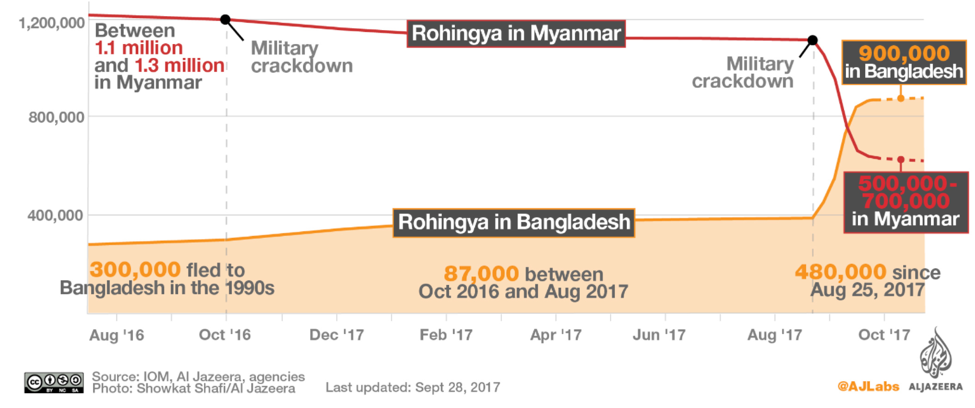Rohingya Refugees Fleeing to Bangladesh Strain Infrastructure
Primary Analyst: Natalie DeGurse
Team Leader: Claire Okrainetz
The current situation in Myanmar has been gaining global attention and is now being classified by the United Nations as a Genocide of the Rohingya people. The Rohingya, a minority ethnic group from Myanmar, has faced persecution by the Myanmar military since the late 1940s. The long campaign of dehumanization of the Rohingya people turned into conflict in 2012, leading to thousands displaced. The situation escalated with a military crack-down starting in August of 2016. This attack on the Rohingya has triggered an influx of 605K Rohingya to Bangladesh since August 25, 2017, joining the previous 300K who fled during earlier waves of displacement. Throughout history, Bangladesh is the main country the Rohingya have fled to as discrimination in Myanmar increased. This migration has led to the majority of the Rohingya people currently living in Bangladesh instead of their in ethnic homeland of Rakhine state in Myanmar, as seen on the graph below.

The speed and scale of the influx of Rohingya into Bangladesh has resulted in a strain on Bangladesh’s infrastructure, services, and population. As a result, the situation has been deemed a critical humanitarian emergency, with high risk of massive loss of life. Without immediate and adequate resources provided to Rohingya refugee camps to improve all conditions due to overcrowding and insufficient infrastructure, mortality rates will rapidly increase due to disease outbreak, horrific conditions, and overpopulation. This strain on Bangladesh is not only bad for the Rohingya refugees in refugee camps, but also draws on Bangladesh’s already fragile infrastructure and their ability to support citizens and upkeep the nation’s basic functions.
The best way to combat this lack of resources is to reach out to international support systems. Bangladesh was ranked as the 47th poorest country in the world as of February 2017 and there is no expectation that they can support this massive influx of Rohingya in addition to supporting their current population. Furthermore, the global attention this issue has attracted, and the classification of the crisis as a genocide by the United Nations, will channel support from both foreign governments and non-governmental organizations. Once Bangladeshi officials have the financial backing they can install strong management teams at each refugee camp to manage large scale installation of infrastructure and basic services, and primary and secondary healthcare implementation. Ultimately, humanitarian efforts need to be strengthened to avoid massive loss of life and to ensure refugees have proper resources and assistance.
In addition to the strain on Bangladesh’s resources negatively impacting the people in Bangladesh, it also could pose a risk for the country’s businesses. In analyzing the risk of foreign investment in Bangladesh, the country’s overburdened infrastructure is an obvious weakness. With the new immigration, this will further strain resources, possibly resulting in more industrial accidents. Industrial accidents occur due to businesses not properly training new employees and using their current factories over capacity. This is typically mitigated by government safety regulation; however, the current Bangladeshi government doesn’t have that capacity. This instability translates to lack of investment security, which will result in the country’s economy becoming more unstable.
Once the newly immigrated Rohingya peoples from Myanmar have settled into Bangladeshi society they will present new opportunities for growth in Bangladesh. Myanmar and Bangladesh are similar in their top industries, meaning that citizens of both countries share many marketable skills. The influx of Rohingya will, in time, help develop and contribute to Bangladesh’s economy. The two countries are close competitors in markets such as textiles and this mass immigration of peoples could sway the scale in Bangladesh’s favor. This can offset the strain on resources and infrastructure through catering to the “abundant cheap labor” that foreign investors are traditionally seeking from Bangladesh. A resurgence in foreign investment would help the struggling sectors directly, as well as extend the governments capacity to implement regulations.
The Rohingya migration is straining the relations between the Bangladesh and Myanmar government as the Myanmar government has proposed the Rohingya as illegal Bangladeshi immigrants. This is especially a concern for Bangladesh’s textile sector; it’s greatest source of foreign currency. To grow this industry, Bangladesh and China were in talks to build a new road that would facilitate trade between Bangladesh and China and ASEAN countries. However, with the tension between Myanmar and Bangladesh growing, this road would no longer be able to follow the desired route through Myanmar.
Looking forward, Bangladesh should continue attempts to peacefully engage and reason with Myanmar. Ultimately, supporting the Rohingya population is an important and noble action by the Bangladeshi government. Once a global crisis management plan for the Myanmar crisis is put into action, and enforced, it will help alleviate some of the strain being put on the Bangladesh-Myanmar relationship. Until then, it is Bangladesh’s best interest to consider alternative trade routes with China and ASEAN countries in order to maintain their foreign trade relations.

